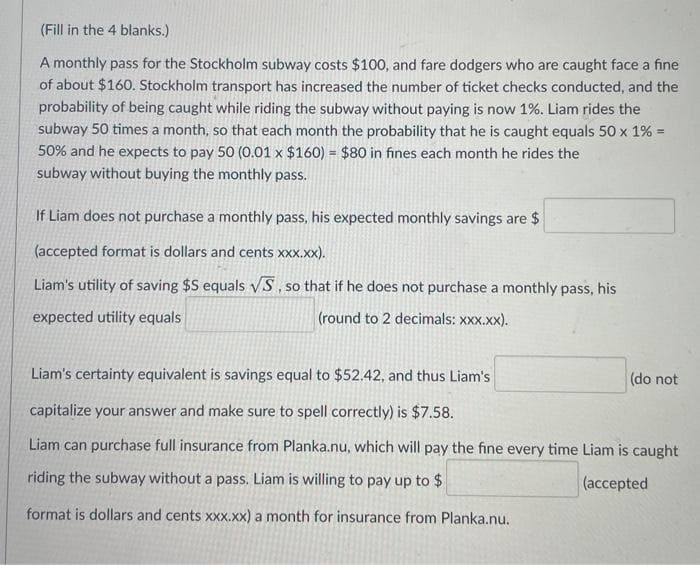A monthly pass for the Stockholm subway costs $100, and fare dodgers who are caught face a fine of about $160. Stockholm transport has increased the number of ticket checks conducted, and the probability of being caught while riding the subway without paying is now 1%. Liam rides the subway 50 times a month, so that each month the probability that he is caught equals 50 x 1% = 50% and he expects to pay 50 (0.01 x $160) = $80 in fines each month he rides the subway without buying the monthly pass.
A monthly pass for the Stockholm subway costs $100, and fare dodgers who are caught face a fine of about $160. Stockholm transport has increased the number of ticket checks conducted, and the probability of being caught while riding the subway without paying is now 1%. Liam rides the subway 50 times a month, so that each month the probability that he is caught equals 50 x 1% = 50% and he expects to pay 50 (0.01 x $160) = $80 in fines each month he rides the subway without buying the monthly pass.
Chapter7: Uncertainty
Section: Chapter Questions
Problem 7.5P
Related questions
Question

Transcribed Image Text:(Fill in the 4 blanks.)
A monthly pass for the Stockholm subway costs $100, and fare dodgers who are caught face a fine
of about $160. Stockholm transport has increased the number of ticket checks conducted, and the
probability of being caught while riding the subway without paying is now 1%. Liam rides the
subway 50 times a month, so that each month the probability that he is caught equals 50 x 1% =
!3!
50% and he expects to pay 50 (0.01 x $160) = $80 in fines each month he rides the
subway without buying the monthly pass.
If Liam does not purchase a monthly pass, his expected monthly savings are $
(accepted format is dollars and cents xXx.xx).
Liam's utility of saving $S equals VS , so that if he does not purchase a monthly pass, his
expected utility equals
(round to 2 decimals: xxx.xx).
Liam's certainty equivalent is savings equal to $52.42, and thus Liam's
(do not
capitalize your answer and make sure to spell correctly) is $7.58.
Liam can purchase full insurance from Planka.nu, which will pay the fine every time Liam is caught
riding the subway without a pass. Liam is willing to pay up to $
(accepted
format is dollars and cents x.xx) a month for insurance from Planka.nu.
Expert Solution
This question has been solved!
Explore an expertly crafted, step-by-step solution for a thorough understanding of key concepts.
Step by step
Solved in 3 steps

Knowledge Booster
Learn more about
Need a deep-dive on the concept behind this application? Look no further. Learn more about this topic, economics and related others by exploring similar questions and additional content below.Recommended textbooks for you


Managerial Economics: A Problem Solving Approach
Economics
ISBN:
9781337106665
Author:
Luke M. Froeb, Brian T. McCann, Michael R. Ward, Mike Shor
Publisher:
Cengage Learning


Managerial Economics: A Problem Solving Approach
Economics
ISBN:
9781337106665
Author:
Luke M. Froeb, Brian T. McCann, Michael R. Ward, Mike Shor
Publisher:
Cengage Learning